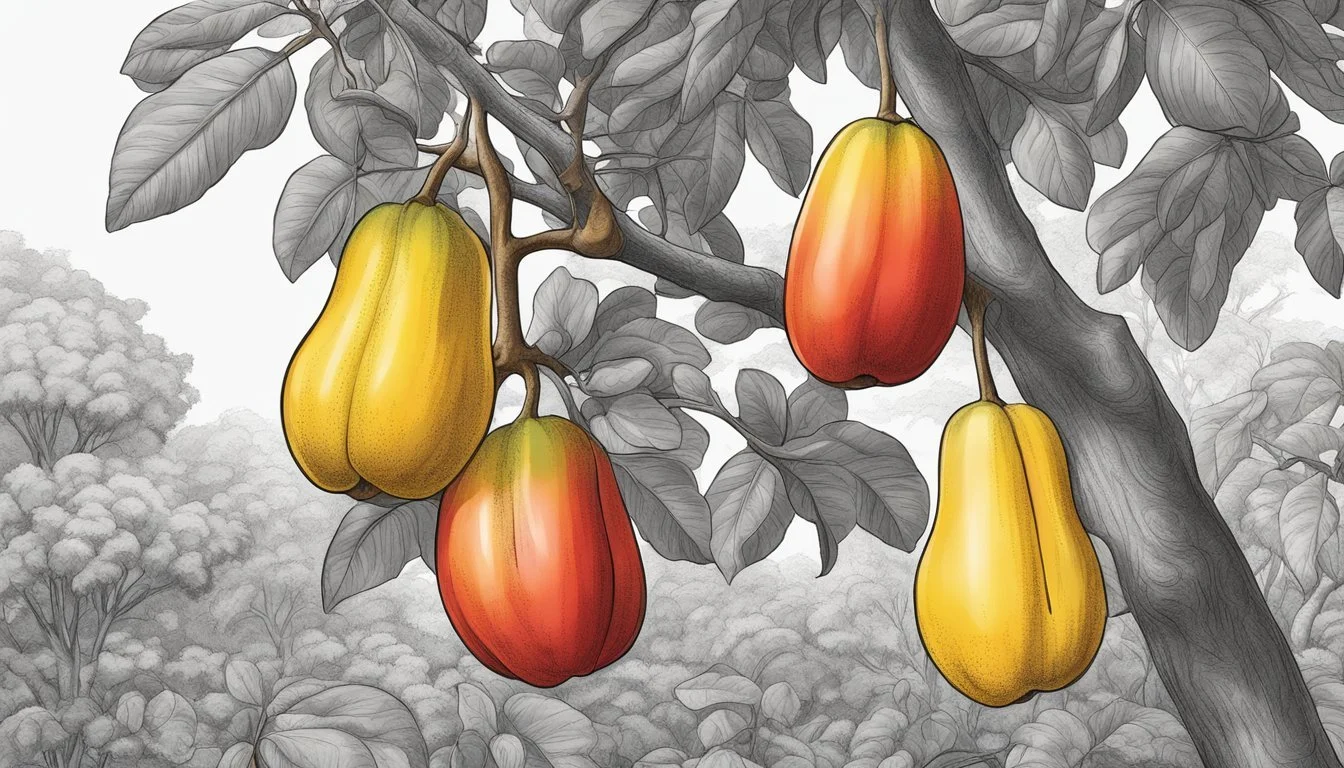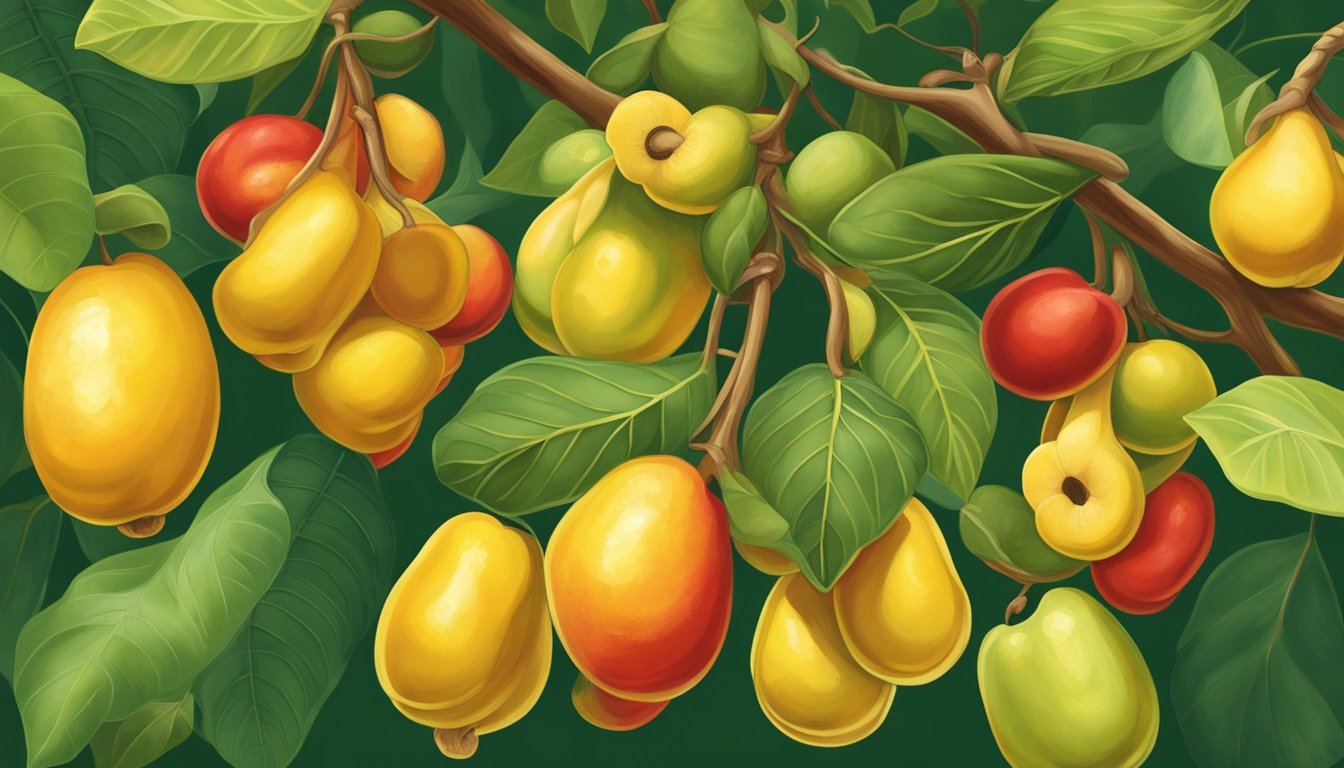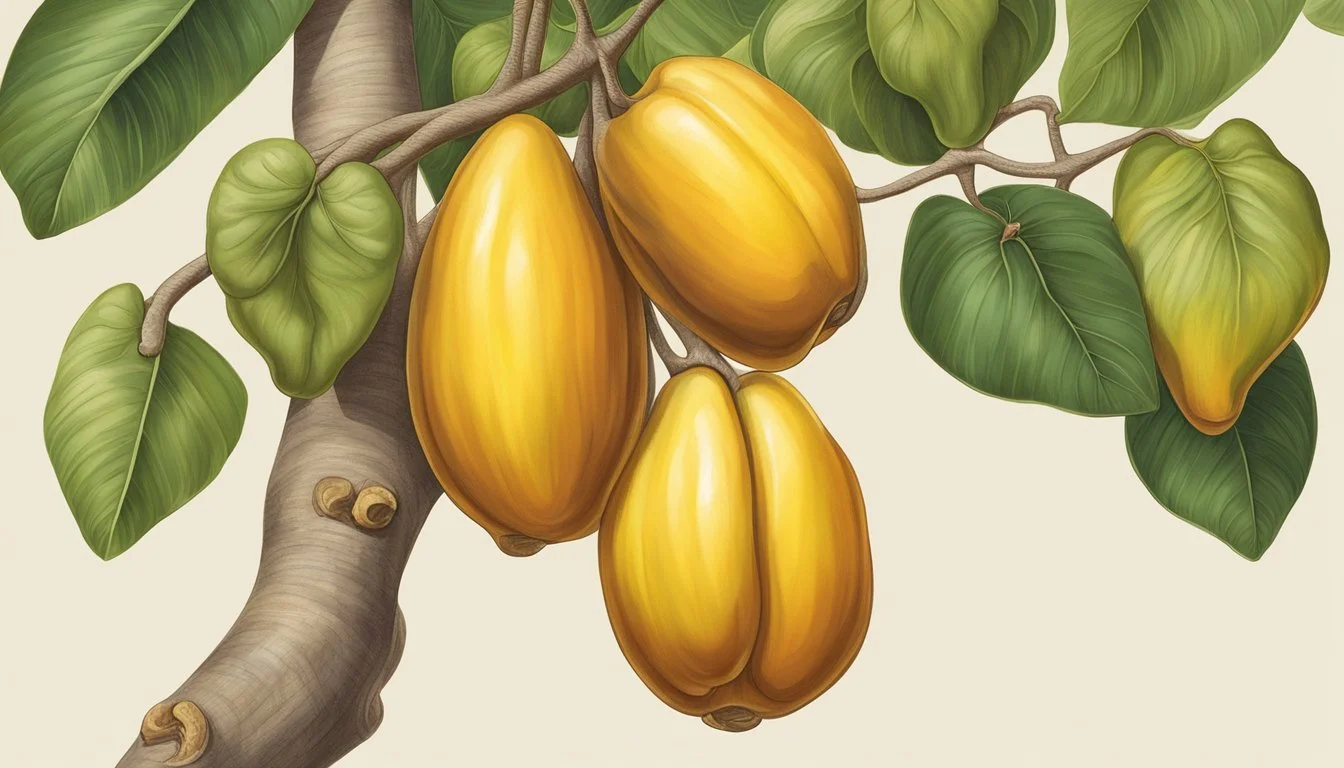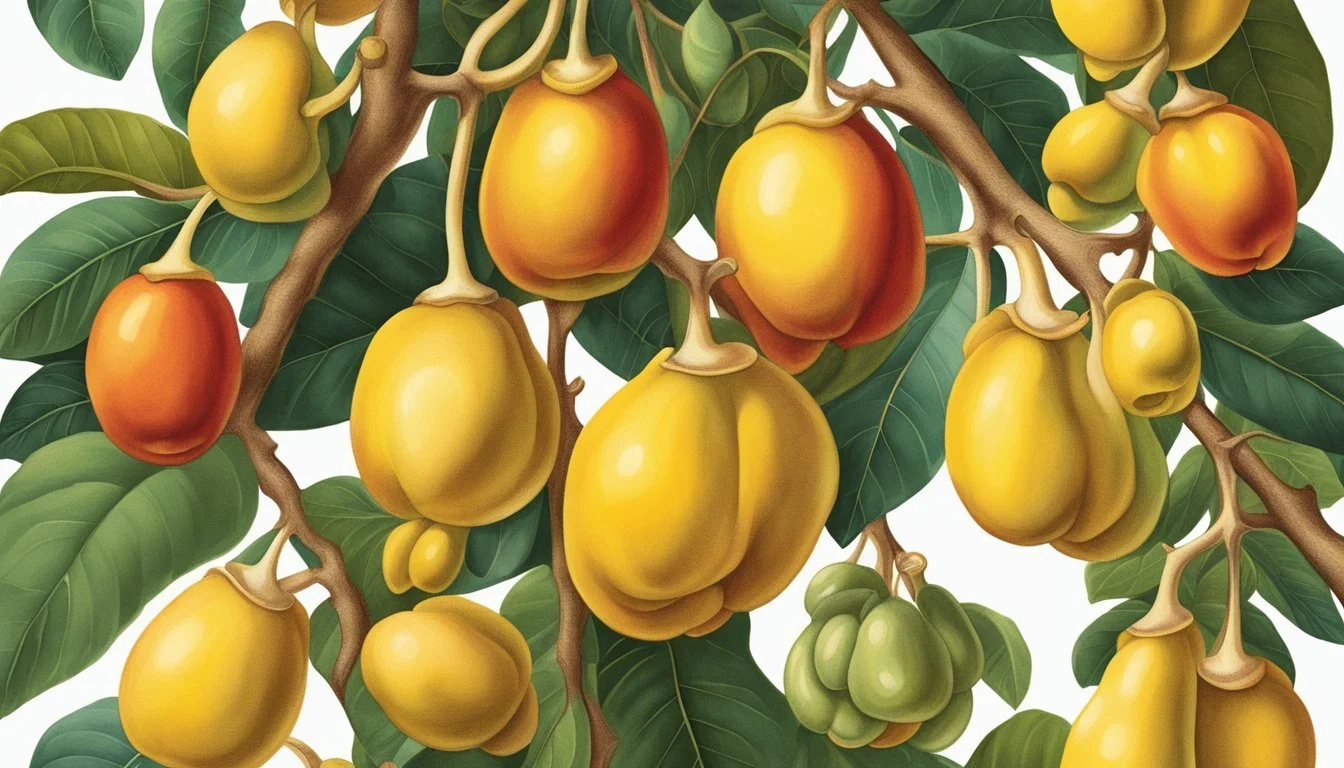How to Tell if a Cashew Fruit is Ripe
Your Expert Ripeness Indicators Guide
To determine if a cashew fruit (What wine goes well with fruit?) is ripe, one needs to be aware of several indicators that ensure the fruit and its nut can be harvested at its best quality. The cashew fruit, also known as the cashew apple, is the part that swells above the cashew nut, which is the true fruit. A ripe cashew apple is a signal that its nut is ready for harvest. The cashew apple showcases a unique growth process where, once mature, the nut develops outside of the apple itself, making cashew trees a fascinating subject for both agricultural and botanical study.
Identifying a ripe cashew fruit is key to enjoying the full array of its sensory and nutritional benefits. A ripe cashew apple will change color, generally turning a vibrant shade of yellow or red, with a pink or red cast. The texture is another giveaway; ripe cashew fruits (What wine goes well with fruits?) are somewhat soft to the touch and should be handled gently to avoid bruising. Gathering these fruits at the right time before they become overripe is essential for optimal flavor and utility, whether consumed fresh, used in cooking, or processed into other products.
When harvesting, one must be cautious with the timing, as the anacardium, or the nut that hangs below the cashew apple, has a strong shell that contains an irritant similar to that found in poison ivy. Proper preparation methods, such as soaking and roasting, are crucial to neutralize this compound and safely enjoy the cashew nut.
Key Takeaways
Cashew apples signal their ripeness through a vibrant color change and softened texture.
The timing of the harvest is crucial to maximize flavor and avoid the caustic substance in the raw nut shell.
Proper handling and preparation are necessary to safely enjoy and utilize ripe cashew fruits and nuts (What wine goes well with nuts?).
Understanding Cashew Fruit Ripeness
Determining the ripeness of cashew fruit is key to enjoying its natural sweetness and optimizing its fresh, tropical flavor. This section outlines the developmental stages of cashew fruit and provides indicators for recognizing when the fruit has reached peak ripeness.
Stages of Cashew Fruit Development
Cashew fruits undergo several stages before they ripen. Initially, the fruit starts as a small swelling on the cashew tree's branches after the flowering period. As it develops, the cashew apple increases in size and undergoes color changes. The fruit's stem end, closest to the tree, is where these changes are first noticeable.
Initial Stage: Green and hard to the touch.
Intermediate Stage: Increasing in size and beginning to show color changes.
Pre-Ripened Stage: Sizable but not yet at the peak of sweetness; color is not fully developed.
Signs of Ripeness in Cashew Fruit
A ripe cashew fruit displays several clear signs that it is ready to be consumed.
Color: When ripe, cashew fruits transform into a vibrant red or yellow hue with a slightly rosy blush. This color alteration is particularly noticeable around the fruit's broadest part.
Feel: They develop a softness that indicates the flesh is juicy and ready to eat. However, one should be cautious as over-softness could indicate over-ripeness.
Weight: The fruit feels heavy for its size when held, suggesting a juicy interior.
Flavor: A sweet and tangy taste characterizes ripe cashew fruit, with the sweetness becoming more pronounced as the fruit matures. If the fruit tastes excessively sour or astringent, it may not have reached full ripeness.
By understanding these stages and signs, one can ensure they select or harvest cashew fruits at the ideal time for consumption.
Physical Characteristics of a Ripe Cashew Fruit
Identifying a ripe cashew fruit requires close observation of its physical attributes. The following subsections will outline the specific characteristics to look for in the exterior color and texture, size and weight, as well as the relationship between the cashew apple and nut.
Exterior Color and Texture
A ripe cashew fruit will exhibit a vibrant color transformation. It transitions from green to shades of yellow, pink, or red. The skin becomes comparatively thin and may display a fine, matte finish as opposed to being shiny. Additionally, the texture of the fruit should yield to gentle pressure, akin to a ripe plum, suggesting a soft but not mushy consistency.
Size and Weight Considerations
While the size may vary, a ripe cashew fruit typically appears plump and heavy for its size, signaling a juicy internal composition. The cashew apple should feel somewhat firm but with a slight give, indicating ripeness without being overripe or spoiled.
Examining the Cashew Apple and Nut
When inspecting the cashew fruit's ripeness, one should also consider the state of the attached cashew nut. A mature, ripe nut turns grey and becomes quite firm. It should look enlarged and feel weighty. Often, nature signals the optimal harvest time as the cashew apple, along with its nut, will detach from the tree and fall to the ground when they are ready to be consumed.
Sensory Indicators of Ripeness
When determining the ripeness of cashew fruit, one must rely on specific sensory indicators. The smell and aroma, alongside the taste profile, are key to identifying if the fruit has reached its optimal ripeness.
Smell and Aroma
Sweet Aroma: A ripe cashew fruit emits a noticeable sweet smell that is distinct and appealing. As the fruit matures, it develops this characteristic fragrance, indicating its readiness for consumption. If a person detects an absence of aroma or an off smell, the fruit is likely not yet ripe.
Smell: While sweetness in the aroma generally suggests ripeness, the presence of any fermenting or sour odors can indicate overripeness. Conversely, an absence of smell or green, grassy notes can denote underripeness.
Taste Profile
Sweetness: Upon tasting, a ripe cashew fruit should have a predominantly sweet flavor profile, reflecting its fully developed sugars. This sweetness is a definitive marker of ripeness.
Tartness: While ripe cashew fruits are characterized by their sweetness, they may also have a subtle tart edge. This tartness should not overpower the sweet notes but rather complement them, providing a balanced taste indicative of ripe fruit.
Cashew Fruit Picking and Harvesting Tips
Harvesting cashew fruit at the right time is vital for quality and safety. The cashew fruit, also known as the cashew apple, should be picked when ripe to ensure the best taste and proper nut development.
Best Practices for Harvesting Cashew Fruits
When harvesting cashew fruits, one should look for a bright red or pink hue and a slight softness to the touch, indicating ripeness. The fruit should still be firm, without soft spots, ensuring it's not overripe. It is essential to check the fruit's attachment to the branches and leaves, as a ripe fruit will detach more easily, usually with a firm twist. One should harvest cashews during the dry season to minimize the risk of fungal infections that are more prevalent in humid conditions.
Visual Inspection: Check for color consistency and absence of soft spots.
Touch: The fruit should be mostly firm with a slight give.
Seasonal Timing: Preferably, harvest during the dry season.
How to Handle and Store After Picking
Once picked, handling and storing cashew fruits properly is crucial for maintaining their quality. The fruits should be handled gently to prevent bruising. The nuts should be separated from the cashew apples as soon as possible to prevent the resin within the nut's shell from affecting the apple. Storing the nuts in a cool, dry place extends their shelf life and preserves their flavor.
Separation: Twist the nut off the apple gently but firmly.
Storage:
Cashew Apples: Consume quickly or process due to perishability.
Cashew Nuts: Store in a cool, dry place away from direct sunlight.
Storing and Preserving Ripe Cashew Fruit
Once cashew fruits reach optimal ripeness, they become highly perishable and require appropriate storage methods to prolong their freshness. Proper storage not only maintains the quality but also ensures that the unique, sweet flavor of the cashew apple is retained.
Room Temperature Storage
At room temperature, ripe cashew fruits should be placed in a well-ventilated area away from direct sunlight. They should ideally be consumed within a day or two to prevent spoilage. For those looking to keep cashew fruits unrefrigerated longer, it is advisable to monitor the fruits regularly for any signs of over-ripening or decay.
Refrigeration and Freezing Techniques
For prolonged storage, cashew fruits can be kept in the fridge. The cooler temperature slows down the ripening process, extending their freshness for up to a week. They should be stored in perforated plastic bags to allow for air circulation and to prevent condensation build-up, which could lead to premature rotting.
To freeze cashew fruits, one should first wash and pat them dry. Slicing the fruit into smaller pieces and removing the cashew nut allows for easier freezing. Store the fruit chunks in airtight containers or heavy-duty freezer bags, ensuring as much air as possible is removed before sealing. Frozen cashew fruit can be used for smoothies or desserts and generally lasts several months in the freezer without significant loss of flavor or texture.
Preparing and Using Ripe Cashew Fruit
Ripe cashew fruits are a versatile ingredient that can be used in a variety of culinary applications, from making refreshing beverages to enhancing dishes with their sweet and tangy flavor. Proper preparation is essential to make the most of this unique fruit.
Washing and Preparation
Before using cashew fruit, it must be washed thoroughly to remove any dirt and residues. After washing, the stem should be removed. If the fruit is ripe, it will have a vibrant color and a slightly soft texture. To prepare it, one should:
Cut the fruit away from the cashew nut.
Slice off the top where the nut was attached.
Cut the fruit into bite-size pieces.
These prepared pieces can be eaten raw, mixed into fruit salads, or used as a topping for desserts.
Incorporating into Recipes and Dishes
Ripe cashew fruit lends a unique flavor to recipes and can be:
Diced and added to fruit salads for a tropical twist.
Pureed and mixed into dessert recipes for natural sweetness.
Incorporated as a garnish for savory dishes, adding a subtle tang.
Cashew fruits can complement both sweet and savoury dishes, making them a valuable addition to a cook's repertoire.
Making Juices and Smoothies
Cashew fruits can be transformed into a variety of beverages:
To make juice, blend cashew fruit with water and strain the mixture to obtain a vibrant and flavorful drink.
For smoothies, combine cashew fruit with other fruits, yogurt, or milk to create a creamy and nutritious snack.
These beverages are not only delicious but also offer hydration and a boost of vitamins.
Nutritional Value and Health Benefits
Before looking at how to ascertain ripeness, understanding the nutritional composition and the benefits of cashew fruit is crucial. This fruit is not just delectable, but it also harbors a wealth of wellness advantages due to its rich content of vitamins, antioxidants, and dietary fiber.
Vitamins and Antioxidants
Cashew fruits boast substantial levels of vitamin C, an essential antioxidant that helps in boosting immunity and neutralizing free radicals. A single cashew fruit can contain a higher quantity of vitamin C compared to some citrus fruits. In addition, cashews are also a source of minerals such as iron and zinc. The antioxidants present in cashew fruits contribute to overall health by fighting oxidative stress and reducing inflammation.
Vitamin C: Key for immune system support and skin health.
Other antioxidants: Aid in preventing cellular damage and reduce inflammation.
Dietary Fiber and Nutrient Content
The dietary fiber content in cashew fruits plays a pivotal role in weight management and digestive health. Fiber helps create a sense of fullness, potentially leading to reduced calorie intake. Furthermore, the fiber in cashew fruits can aid in stabilizing blood sugar levels, thereby curbing sugar cravings.
Here's a breakdown of key nutrients and how they benefit health:
Dietary Fiber: Supports digestion and may promote satiety, aiding in weight control.
Magnesium and Phosphorus: Contribute to strong bone health.
Copper: Essential for energy production and iron absorption.
Vitamins, such as Thiamin and Vitamin B6: Supports metabolism and nerve function.
Cashew fruit's contribution to nutrition offers multiple health benefits, encompassing weight management, enhanced immunity, and a well-supported digestive system.
Avoiding Overripe and Spoiled Cashew Fruit
Selecting the perfect cashew fruit involves understanding the signs of overripeness and spoilage. This knowledge can prevent the consumption of undesirable fruit and ensure a pleasant experience.
Identifying Overripeness
When cashew fruit becomes overripe, it often exhibits certain physical changes. Typically, overripe cashew fruit will display:
Skin texture: An overly soft, mushy consistency beyond the usual tenderness of ripe fruit.
Color changes: A color that has darkened significantly, losing the bright hues associated with optimal ripeness.
One should also look for brown spots and areas that seem bruised—these can indicate that the fruit is past its prime.
Telltale Signs of Spoilage
To dodge potential health issues that come with eating spoiled cashew fruit, one must be vigilant for:
Odor: A sour or fermenting smell is a clear red flag, signifying spoilage.
Visible mold: Any presence of mold, especially around the stem or the fruit's crevices, is an indicator that the fruit should be discarded.
Taste test (if odor and visual inspection pass): An off flavor, such as bitterness, is cause to stop consumption immediately.
Consistent inspection for these signs ensures that one enjoys cashew fruit at its best and avoids the risks associated with overripe or spoiled produce.
Exploring Varieties and Regional Differences
The ripeness and taste of cashew fruits are influenced by their variety and the climate of the region where they are grown. Recognizing these factors is key to determining the optimal time for consumption.
Cashew Fruit Varieties
Cashew fruits, also known as cashew apples, come in various shapes and sizes. The color of ripe cashew fruits can range from yellow to red, and their shape may vary from round to pear-shaped. These variations reflect the diverse genetic makeup of cashew trees, which can also impact the flavor and texture of the fruit. For instance, some varieties have a sweeter taste, while others are more astringent.
Common Cashew Fruit Varieties:
Acajou: Known for its sweet, slightly tangy flavor.
Maranon: Typically larger in size with a more fibrous texture.
Giant Cashew: As the name implies, these fruits are big with a robust flavor.
Climatic Influence on Ripeness and Taste
Cashew trees thrive in tropical climates with warm temperatures and high humidity. The climate not only affects the growth and health of the cashew tree but also the ripeness and taste of the fruit. Cashew fruits grown in constant tropical conditions tend to develop a more balanced flavor profile, with the right mix of sweetness and acidity.
Impact of Climate on Cashew Fruit:
Temperature: Optimal ripening occurs in temperatures ranging from 25-28°C (77-82°F).
Rainfall: Adequate rainfall promotes lush green leaves, which contribute to the overall health of the fruit.
Sunlight: Sun exposure is necessary for the development of the fruit's rich colors and flavors.
Understanding the variety and the specific regional climate where cashew trees are cultivated can provide valuable insight into the ripeness and taste nuances of cashew fruits.
Frequently Asked Questions
When selecting cashew fruit, it's important to know when they are ripe and how to consume them for the best experience.
How to Pick the Perfect Cashew Fruit
To ensure one picks a ripe cashew fruit, they should look for a fruit that has a vibrant color, typically ranging from yellow to red. The fruit should yield slightly to a gentle squeeze, indicating a ripe and soft texture. The cashew apple should not have any blemishes or signs of rot. A ripe, fresh cashew fruit will often emit a sweet aroma, indicative of its readiness to be eaten.
Can You Eat Cashew Fruit Raw?
Yes, cashew fruit can be eaten raw. When consuming a fresh cashew apple, one should expect a soft texture and a sweet, slightly tangy flavor. It is imperative to avoid the raw cashew nut, which is attached to the bottom of the fruit, as it contains urushiol, a substance that can be harmful if ingested in its raw form.








